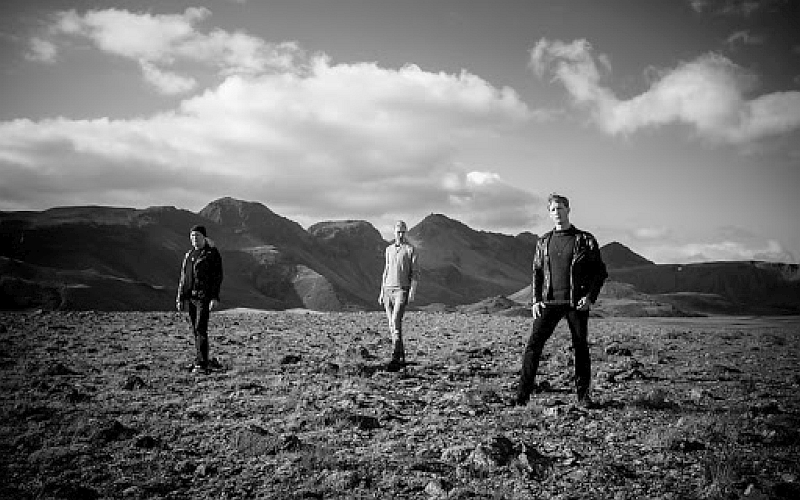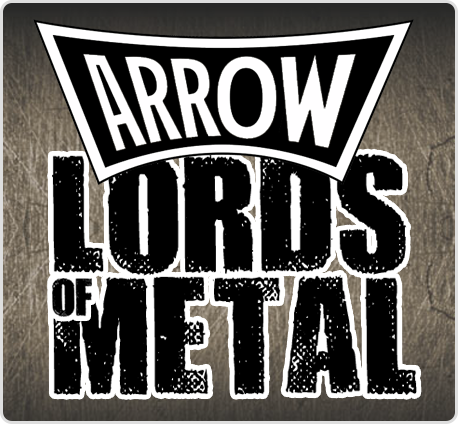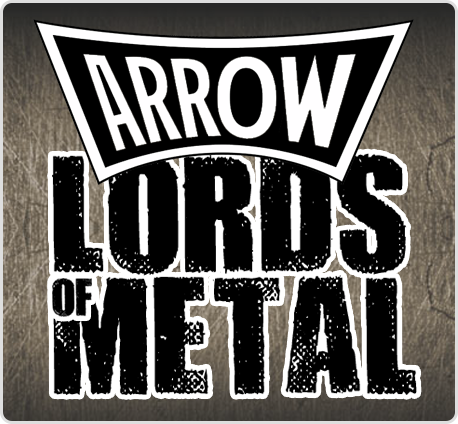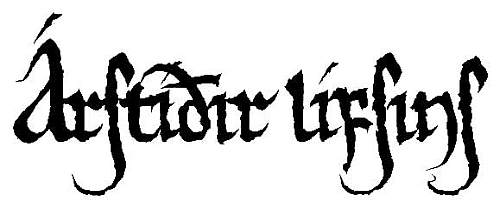
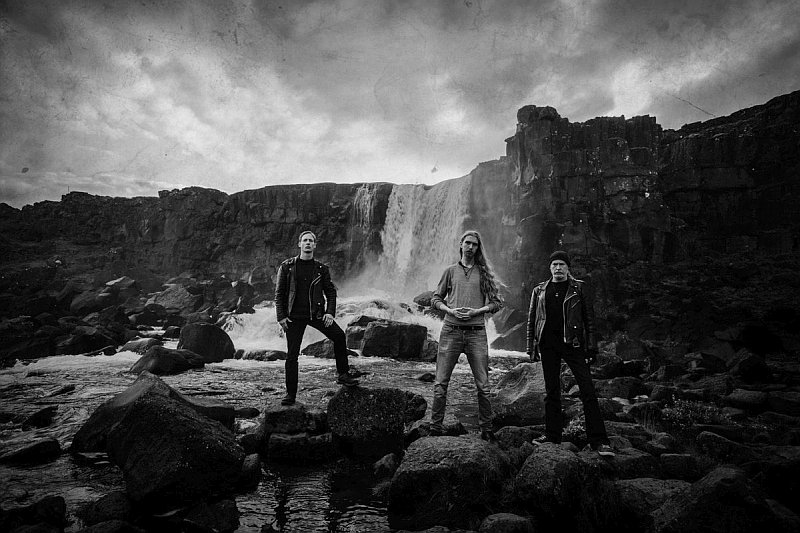
Stefán: “The lyrics on the two albums remain somewhat up to date, without question. However, I doubt whether this can be transferred directly to our times. Personally, I enjoyed writing and selecting the primary sources that the solo trips described in the wilderness and the associated mythological experiences of the second part. To me, they have a certain timeless touch.”
Árstiðir lifsins is een band opgericht door een Duits student Stefán, gefascineerd door IJsland en diens erfgoed, alsook aloude Noordse talen en verhalen. Een buddy vond hij in Marsél, bekend als zanger van Helrunar. Het derde lid van de band is Árni, een rasechte IJslander. Men heeft zonet een uitgebreide saga voleindigd die vorig jaar een aanvang nam met ‘Saga á tveim tungum I: Vápn ok viðr’ en recentelijk een vervolg kreeg met het al even fascinerende ‘Saga á tveim tungum II: Eigi fjǫll né firðir’. Vandaar dat dit het geschikte moment was om even uitgebreid in te gaan op beide albums met de bezieler Stefán.
Vera Matthijssens Ι 01 juni 2020
How are you? Are you living in Germany at the moment or in another country? Hope you’re doing well…
Hello Vera and thanks for this interview. I am living in Norway at the moment. Fortunately, I am doing well here.
We had a lengthy interview in 2015, but now that the second part of ‘Saga á tveim tungum’ will be released, I’d like to ask you about both Saga albums for our next update and interview. First of all, writing two albums, both of considerable length, must have been a huge challenge. When and how did you manage to do that?
Our ways of writing music and lyrics for the newest album did not change that much, to be honest. Over the last few years, we established a well working mode of production, which helped us a lot to write, record and finish the newest recordings. Nevertheless, it was quite a lot to record, that is for sure. But then again, once it is released and finished, I usually forget about the efforts it took.
I remember you told me that every album happens to be a cycle, going through a year from winter to winter again. Is this idea also reflected on both these recent albums? In which way?
Yes, all our albums usually depict a single or two lives, reflect in a circle of the four seasons. But our newest two albums did not. This first and foremost is caused by the different story we tell on these releases, and the historical events that we had to integrate. For example, the final battle at Stiklastaðir happened during summer, not in winter during which our albums usually end.
First of all can you tell a bit of the main titles of both albums (exact and profound translation, link with the rest of the lyrics, etc…)?
‘Saga á tveim tungum’, the main title of both albums, translates to ‘(a) story (told) in two languages’. Since the two albums tell two different stories built upon the same historical events, we found the main title most fitting, since they both are so closely related in many ways yet so different in their religious beliefs. ‘Vápn ok viðr’, the title of the first part, translated to ‘Weapon and wood’. Wood, or tree, is a common expression in the Skaldic corpus for a warrior, who by the end of his life (at the battlefield) is “cut” and killed. Since the first album depicts the uprising and life of a miles christianus, a follower to the Christian king and saint Óláfr Haraldsson (995-1030), it was fitting to use this straight-forward and violent title. ‘Eigi fjǫll né firðir,’ the second part, translates to ‘Neither mountains nor fjords’ and is a bit more complex. With both the main title and the title for the second album, we wanted to draw attention to the social and religious changes that are dealt with in the lyrics. Neither mountains nor fjords – as places of residence – are symbolically spared from these changes. The rural character of the Norwegian society in the eleventh century is one of the main elements in the texts. Since that album plays largely in the inner part of Norway, while the first has a largely maritime character, it was fitting to also reflect this in the title.
Did you write all lyrics yourself or can we find traces or parts from existing texts in it too, only rendered?
Since our first album, released some good ten years ago, I have been using extensively Skaldic and Eddic stanzas in our lyrics. Nevertheless, apart from the stanzas, the lyrics are written by me. Due to the Christian-combative orientation on ‘Vápn ok viðr’, I used many Christian Old Norse synonyms (heiti) and paraphrases (kennings), as well as corresponding Skaldic poetry and descriptions from the kings’ sagas. On ‘Eigi fjǫll né firðir’, on the other hand, I used a large number of pagan paraphrases derived from the Eddaic and Skaldic poetry, which are deeply rooted in the mythological understanding of the western Scandinavian society at that time. This may give the album a certain pre-Christian religious touch.
In big lines, can you tell us the story that’s running through both albums?
After the fratricide which ends our last album ‘Aldafǫðr ok munka dróttinn’, the wife of one of the two brothers and their two children flee to Norway on a ship. The ship sinks, the mother drowns, and the siblings are separated: the brother almost drowns too but is saved by one of King Óláfr’s ships. He now grows up in the wake of the king and develops into a Christian believer. After a lost battle in eastern Sweden, the king must flee to the Rús. He soon returns to Norway – and eventually dies in the mentioned Battle of Stiklastaðir. The protagonist of the first album also dies there. The second part deals with the story of the sister. She survives that shipwreck and grows up in a largely non-Christianized environment in the Norwegian valley of Guðbrandsdalr. The political, religious and, not least, social tensions of the time did not fail to occur there either, and the sister flee from the valley. Before that, she had already found out about her brother’s existence in dreams and decides to search for him. Fleeing from the king’s henchmen, she wanders through the wooden wilderness. Her aim, nevertheless, is similar as the one of her brother’s: approaching the battle of Stiklastaðir. There, she eventually finds her brother who dies in her arms.
Music-wise I think it covers the whole Árstiðir lifsins sound, but even bigger. But how do you see the musical development and content as creator? For instance, what was new, what was a special challenge?
It is always a bit hard to interpret the own music and lyrics generally, but I too have the impression that ‘Saga á tveim tungum’ is our most adventurous and varied work thus far. Especially ‘Eigi fjǫll né firðir’ features a number of new or at least previously less used forms of music for us. I look very much forward to have them more integrated in the music of our future releases.
Is there for you a kind of wisdom in these ancient texts you study and is there a kind of ‘lesson’ hidden in the theme(s) of the album? In other words, can we reflect it on modern times?
From time to time a certain pessimistic world-view seems to appear in the original sources. Furthermore, as is known, the willingness to raise deep conflicts by people driven by extreme religious views is still very high, so the lyrics on the two albums remain somewhat up to date, without question. However, I doubt whether this can be transferred directly to our times. Personally, I enjoyed writing and selecting the primary sources that the solo trips described in the wilderness and the associated mythological experiences of the second part. To me, they have a certain timeless touch. Nevertheless, I cannot (and I do not want to) predict if listeners and readers benefit from them or not.
In this huge work, can you shine a light on the contributions of your band mates Marsél and Árni? Was their input more? Or less? Were they responsible for some parts in the creation?
Yes, of course. Both have a very strong impact on the music, and the content of the lyrics is always deeply discussed before we start the vocal recordings. Music-wise, Árni contributes not only the drums, but also all orchestral works and quite a few of the choir arrangements. Marsél, on the other hand, works equally strong on the choirs, and has his own distinct way of narrating parts of the lyrics. So both Árni and Marsél are certainly not less involved in the writing of the music than I am.
How did you select the material (order of songs, which songs on second album…)? Was it based on the lyrics (story), on the music or in order of writing it?
Yes, the story came first and determined the music on both albums.
I remember you once started the band due to your fascination for Iceland. Do you still go there often? (well, before the corona crisis I mean of course) It must be a big difference with 2008 (in bank crisis) and the prosperous country it became recently… How is your bond with the country nowadays?
I have been to Iceland quite a few times since 2008, among others due to work-related activities. I am still very fascinated by its culture, art and history, and my enthusiasm has certainly not faded over the years.
We are living in completely different times than the ones when these albums were created. Did that corona crisis hit you in being creative or in your life until now? How do you adapt and make the best of it?
Fortunately, not. I am mostly working from home and have recently started to work on our next records with a similar working mode than before. It is a bit unfortunate that we cannot play live with Helrunar now, but there are others that suffer much more from this crisis than I, or we, do.
Are you already working on new stuff and if so, what can you reveal about your future plans and creations?
Yes, as mentioned. I have already started working on the concepts of the upcoming album and an EP. For the EP, I would like to work with the mythological appearance of the animals of Óðinn. Surely these have already been treated by a lot of bands. However, I think that these animals are much more complex mythological phenomena than is commonly portrayed in heavy metal.
We all know that the music of Árstiðir lifsins is best after repeated listens, but which songs should you suggest to start with from both albums to our readers?
I would personally suggest listening first to the seventh song on ‘Eigi fjǫll né firðir’, ‘Er hin gullna stjarna skýjar slóðar rennr rauð’.
To occlude, can you say few words about the ‘Aldrnari’ split you recently made with Carpe Noctem and the AL song on it?
‘Aldrnari’ is the collaboration of both bands and explores themes of death and war, fire and life. Both bands have dealt with the ambivalence of the title, and have interpreted it from various mythological and philosophical points of view. It is a very interesting release, both lyrically and musically, and I am very proud of it, no doubt.
If there is anything you’d like to add, please feel free to do it here…
Thank you for the interview.
